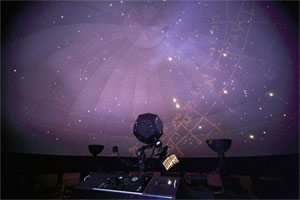 |
| Amy Chapman and Jacqueline Byers, both going into second-year physics, are two of the Halifax Planetarium's operators. (Danny Abriel Photo) |
Quick! Where’s a dodecahedron located at Dalhousie?
Dodeca-whata?
A dodecahedron—a 12-sided contraption with pentagonal faces, this one made of metal—is located in the Halifax Planetarium in the Dunn Building. There’s a light source inside, which emits through various lens and pinholes, and projects the night sky on to a fabric dome.
For more than 50 years, generations of Halifax kids—and older folks too—have learned about the stars, constellations and faraway galaxies at the planetarium. Originally located in the Nova Scotia Museum when it was situated on Spring Garden Road, there was no longer room for it when the museum moved to its current home on Summer Street and the planetarium was put into storage. It was later brought to Dalhousie and re-opened in 1979.
“We actually think it’s just marvelous,” says Stephen Payne, “unofficial director” of the Halifax Planetarium and an instructor in the Department of Physics and Atmospheric Science. “Although it’s based on a simple idea and now fairly old, it’s still perhaps the best way to portray the night sky.”
|
About 40 people can fit under the dome, which is about six metres across by five metres in height.
Until about the mid-1990s, the planetarium hosted many shows for school groups, community groups like Girl Guides and Scouts, and members of the public. But the attendance dropped off as the job of presenting shows fell to fewer people.
In preparation for 2009, the International Year of Astronomy, there’s been a push to revitalize the planetarium—an idea arrived at concurrently by folks at Dalhousie, the Nova Scotia Museum and the Halifax Centre of the Royal Astronomical Society of Canada (RASC). Already this year, more than 1,600 people have been through, including more than 500 school kids at Physics and Fun Discovery Days sponsored by the Department of Physics and Atmospheric Science at the end of May.
 |
| The Spitz Model A-1 star projector and the dome of the Halifax Planetarium. (Peter Klages Photo) |
Initiatives include training a new pool of enthusiastic operators, including Dal science students, and paying them for shows they host. To do that, nominal admission charges have been brought in for some public shows.
Although small compared to other planetariums still operating in Canada, the Halifax Planetarium is known for its intimate, friendly atmosphere that allows for interaction between the operator and audience members.
“That’s the nice thing about our planetarium—if you have a question you can just ask the operator,” says David Tindall, associate professor with the Department of Physics and Atmospheric Science, who uses the planetarium for some of the classes he teaches. He notes the McLaughlin Planetarium, associated with the Royal Ontario Museum in Toronto, has been shutdown for a decade. “But we feel we have something special here and worth holding on to.”
Because of light pollution—light that spills into the night and causes a glow over urban and suburban areas—the planetarium offers a view of the heavens that many who live in cities rarely see.
“The teachers and chaperones accompanying the school groups frequently exclaim how good the shows are and how much the kids enjoy them,” says Dr. Payne. “It’s a revelation to us, but then, if they live in the city, they hardly ever see the stars anymore.”
Halifax's hottest attraction in 1955Forest Fyfe, an instructor with the Department of Physics and Atmospheric Science, recalls attending a show at the Halifax Planetarium during the first year of its operation. The then-11-year-old summer camper said the trip to the planetarium ignited a love of astronomy that continues to this day. At the time, the planetarium’s dome was decorated with the Halifax cityscape at its base. The buildings were made with black fabric and sewn on, with tiny light bulbs at the windows. There was even a silhouette of the Angus L. McDonald Bridge, then just a year old. “I remember it all quite vividly,” said Mr. Fyfe. |
